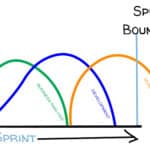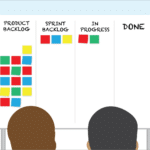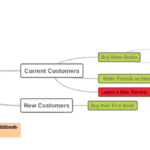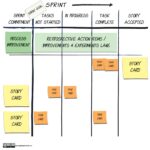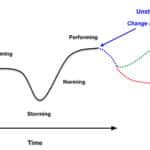Is your Scrum team struggling with questions about who owns quality? Is testing way behind development? Are team members claiming no time for retrospective because they’re focused on delivery? They might be victims of what some call Scrummerfall, or Mini Waterfall. Let’s use our fictional World’s Smallest Online Bookstore (WSOBS) Scrum team to explore what […]
The Modern Guide to the Daily Scrum Meeting
Many people who attend Scrum training courses start with the impression that the Daily Scrum is the whole of Scrum. Others think the Daily Scrum centres on three questions (this was true a long time ago). This guide to the Daily Scrum meeting was created to address these misconceptions as well as answer common questions. […]
Impact Mapping – What It is, in Depth, with Examples
Work is humming along nicely when your Marketing VP stops by your desk and says, “We need to double monthly sales.” That’s it. That their entire instruction. After you recover from this bombshell, you will need to decide what tool you will use and who you will grab to help you start to tackle this […]
Scrum by Example – Product Backlog Refinement in Action
In Scrum, Product Backlog Refinement is an essential meeting of the Product Owner and the Development Team to gain clarity and a shared understanding of what needs to be done through discussion and sharing of ideas. The following is a guide example of how to run an effective Product Backlog Refinement meeting. We know that many people learn […]
Scrum by Example – Team Friction Inspires Working Agreements
Scrum team Working Agreements are a simple, powerful way of creating explicit guidelines for what kind of work culture you want for your Team. They are a reminder for everyone about how they can commit to respectful behaviour and communication. In this post we’ll see how the fictional World’s Smallest Online Bookstore (WSOBS) Scrum team struggles […]
The Sprint Backlog: A Truly Complete Guide with Examples
We might not be able to make Sprint Backlogs exciting, but we can make them more effective. Let’s look at what a Sprint Backlog is, what purpose it serves, and how to create, manage, and improve it. What is a Sprint Backlog? A Sprint Backlog is a list of Product Backlog Items (PBIs) that the Developers think they can complete during the […]
The Spotify Model of Scaling – Spotify Doesn’t Use It, Neither Should You
The “Spotify Model” probably isn’t a model and definitely isn’t what is currently practiced at Spotify today. (Some suggest it never was.) The below image was made famous in a video by Henrik Kniberg, where he explains how work was organized into Squads, Tribes, and Guilds. Many people see the structure and try to mimic […]
In Agile, Where Change is Valued, Why Is a Stable Team So Important?
A stable team is one in which team membership doesn’t change often and, instead, is consistent over time. Why should we care? Isn’t Scrum like basketball where you can change the players on the court anytime there is an interruption? Let’s find out… High-performing teams —or teams that gets stuff done with insanely high quality— […]
